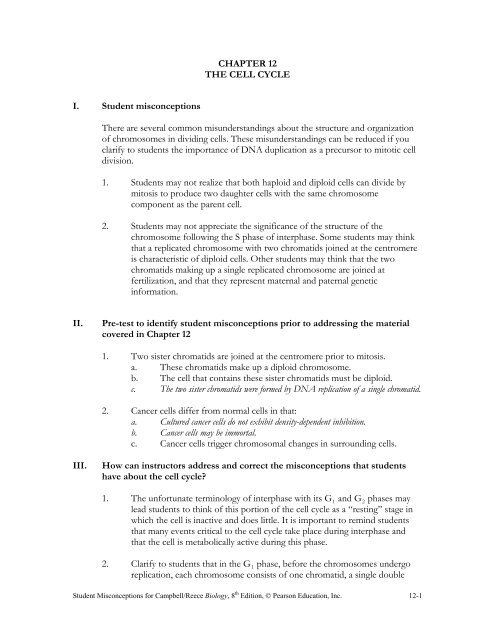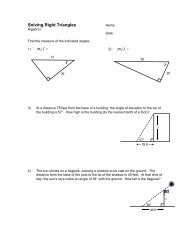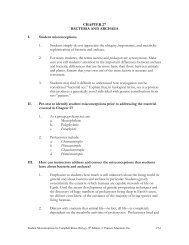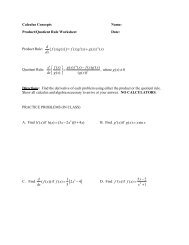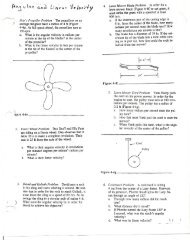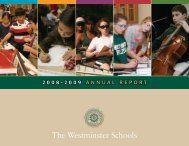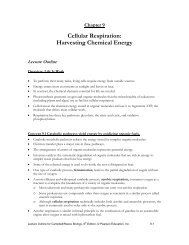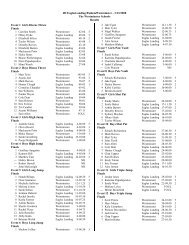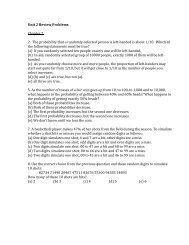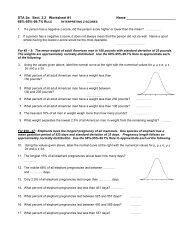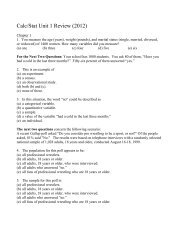CHAPTER 12 THE CELL CYCLE I. Student misconceptions There ...
CHAPTER 12 THE CELL CYCLE I. Student misconceptions There ...
CHAPTER 12 THE CELL CYCLE I. Student misconceptions There ...
Create successful ePaper yourself
Turn your PDF publications into a flip-book with our unique Google optimized e-Paper software.
<strong>CHAPTER</strong> <strong>12</strong><strong>THE</strong> <strong>CELL</strong> <strong>CYCLE</strong>I. <strong>Student</strong> <strong>misconceptions</strong><strong>There</strong> are several common misunderstandings about the structure and organizationof chromosomes in dividing cells. These misunderstandings can be reduced if youclarify to students the importance of DNA duplication as a precursor to mitotic celldivision.1. <strong>Student</strong>s may not realize that both haploid and diploid cells can divide bymitosis to produce two daughter cells with the same chromosomecomponent as the parent cell.2. <strong>Student</strong>s may not appreciate the significance of the structure of thechromosome following the S phase of interphase. Some students may thinkthat a replicated chromosome with two chromatids joined at the centromereis characteristic of diploid cells. Other students may think that the twochromatids making up a single replicated chromosome are joined atfertilization, and that they represent maternal and paternal geneticinformation.II.Pre-test to identify student <strong>misconceptions</strong> prior to addressing the materialcovered in Chapter <strong>12</strong>1. Two sister chromatids are joined at the centromere prior to mitosis.a. These chromatids make up a diploid chromosome.b. The cell that contains these sister chromatids must be diploid.c. The two sister chromatids were formed by DNA replication of a single chromatid.2. Cancer cells differ from normal cells in that:a. Cultured cancer cells do not exhibit density-dependent inhibition.b. Cancer cells may be immortal.c. Cancer cells trigger chromosomal changes in surrounding cells.III.How can instructors address and correct the <strong>misconceptions</strong> that studentshave about the cell cycle?1. The unfortunate terminology of interphase with its G 1 and G 2 phases maylead students to think of this portion of the cell cycle as a “resting” stage inwhich the cell is inactive and does little. It is important to remind studentsthat many events critical to the cell cycle take place during interphase andthat the cell is metabolically active during this phase.2. Clarify to students that in the G 1 phase, before the chromosomes undergoreplication, each chromosome consists of one chromatid, a single double<strong>Student</strong> Misconceptions for Campbell/Reece Biology, 8 th Edition, © Pearson Education, Inc. <strong>12</strong>-1
helix of DNA. Sister chromatids are produced only if and when the cellenters the S phase.3. Remind students that the events of mitosis and cytokinesis are continuousand that cell division is organized into discrete stages largely for convenience.The use of time-lapse films of cell division may help to make this point.4. <strong>Student</strong>s may be motivated to understand the complex components of thecell cycle control system through a discussion of the loss of cell cyclecontrols in cancer cells.5. Reinforce the link between chromosome behavior and the transfer of geneticinformation in discussing cell division and fertilization. To help studentsunderstand the cell cycle and cell division in context, remind them of the roleof mitosis, meiosis, and fertilization in a variety of life cycles, emphasizingthe continuity of genetic information.IV.Post-test to identify whether students have corrected their <strong>misconceptions</strong>1. Two chromatids are joined at the centromere prior to mitosis.• Identify each statement as CORRECT or INCORRECT.• Change each incorrect statement to a correct one.a. These chromatids make up a diploid chromosome.Incorrect – These chromatids make up a replicated chromosome.b. The two chromatids contain the same genes in the same linearsequence. Correctc. Barring mutation, the two chromatids are identical. Correct2. “Cancer cells have escaped from cell cycle controls.” Explain this statement,with reference to specific cell cycle controls that affect normal cells.<strong>Student</strong> Misconceptions for Campbell/Reece Biology, 8 th Edition, © Pearson Education, Inc. <strong>12</strong>-2


